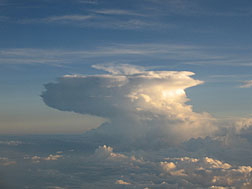- Number 378 |
- December 17, 2012
Tropical clouds go from Dr. Jekyll to Mr. Hyde

From Jekyll to Hyde, this anvil cloud is an
example of tropical clouds that evolve from
fair-weather to stormy. Scientists at PNNL
used observational data and high-resolution
modeling to uncover and rank the key
environmental conditions that encourage
this transformation.
It’s a suspense story with a world-climate conclusion. Using high-resolution model simulations, two scientists from DOE's Pacific Northwest National Laboratory uncovered four unique conditions that turn fair-weather clouds into tropical storm clouds. Among four environmental factors, the presence of moisture and vertical wind velocity events, about one hour before the cloud forms, are the prime culprits. The researchers validated the model results with data gathered by a collection of U.S. Department of Energy instruments.
Weather is born in the turbulent tropics. A continual cycle of heat and moisture is pulled from the tropical ocean and transported around the globe on belts of atmospheric energy. Tropical clouds are at the leading-edge of these forces. Understanding how they form, and replicating their lifecycle in global climate models, remains an elusive goal for those aiming to project climate changes accurately.
Scientists need a better understanding of how different environmental factors, like moisture and wind, control the timing of clouds’ transition from fair-weather to rainstorm clouds. The unique mathematical technique developed by Dr. Samson Hagos and Dr. L. Ruby Leung, atmospheric scientists at PNNL, integrates field observations and cloud-resolving models to identify environmental variables important for tropical storm-cloud creation: moisture, vertical velocity, potential temperature, and equivalent potential temperature. This climate research will enable better representation of tropical clouds in global circulation models.
This work is supported by the DOE’s Office of Biological and Environmental Research Atmospheric System Research program.[Kristin Manke, 509.372.6011,
kristin.manke@pnnl.gov]
